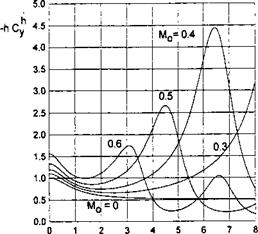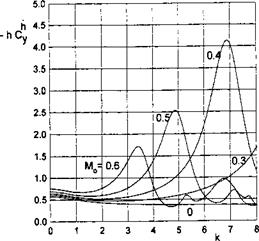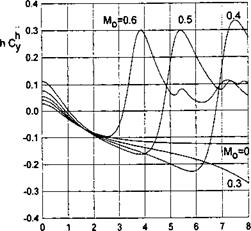Compressible Linearized Unsteady Flow Past a Wing of Finite Span
|
dh* d h* dx dt * |
In paragraphs 5.1. and 5.2., both nonlinear and linear compressible flows around a wing in the extreme ground effect were discussed, and corresponding approximate mathematical models were proposed. In this paragraph based on a linear formulation, the flow problem for a rectangular wing in the extreme ground effect will be treated for harmonic dependence of perturbations on time. Recall equation (5.19) for linear compressible flow past a wing in the extreme ground effect, omitting subscript ul{K.
With the intention of investigating a representative example of heave oscillations of a rectangular wing, we represent the instantaneous local gap and velocity potential as
/i*(x, 2, t) — h — h0iexp(ikt), (p(x, 2, і) = ф(х, z) exp(ifc£), (5.35)
where к = ujC0/U0 is the Strouhal number, і = /—Ї – Taking into account of (5.35) equation (5.34), yields
![]() h0k
h0k
T
We express the complex amplitude of the channel flow velocity potential ф in terms of a series that satisfies the condition of zero loading at the tips of the wing:
°° 7Г
<p(x, z) = ^Txn(x) cosqz, qn = -(2n + l), (5.37)

n=0
The resulting equation with respect to functions Xn(x) can be written as (1 – M02)X" + 2iMg k2X’ + (k2M^ – qn)X = Q, д = _4^(~1)" (5 39)
The characteristic equation for (5.39) is
![]()
|
к
with roots
 |
|
|
|
|
|
![]()
where Xnp&rt(x) is a particular solution equal in this case to Q/(k2M{2 — q2).
Recalling that the perturbed flow potential to this order should satisfy two boundary conditions, namely, ip = 0 at the leading edge (x = 1) and
=0
dx dt
at the trailing edge (x = 0), we can write, respectively,
Ф( 1) =0, Xn( 1) = 0 (5.43)
and
g-i^ = 0, X’n-ikXn = 0 x = 0, (5.44)
Applying the requirements (5.43) and (5.44), we can obtain the following expressions for the coefficients of the solution series
A _ V A* = X ______________________ ifcexp(/i2n) + !Hn – ik______________
П npart „ – p-exp^^^-i^-exp^)^-^)’
ifcexp(/Ui„) + Ціп – і к

 "part^n – «part exp(p2n)(Atln “ І&) ~ ЄХ-Р(Ціп)(М2п – Ік) The lift coefficient is obtained by integrating the loading
"part^n – «part exp(p2n)(Atln “ І&) ~ ЄХ-Р(Ціп)(М2п – Ік) The lift coefficient is obtained by integrating the loading
|
(S-**)didz = ~ exp(ikt) -—— [ (Xf — іkX) dx = Cy exp(ikt). (5.47) A n=n Qn Jo |
|
oo Су = -^Хпр^{і+ік+А*п n=0 |
|
і+і^ехр(/х, п – *> |
 |
The final expression for the complex amplitude of the lift coefficient is
Cy(t) = C$h + tfh, (5.49)
where
![]() rh _ Щ, rh=*£v
rh _ Щ, rh=*£v
y~ h0k’ V h0k2’
where 5ft and 5 are real and imaginary parts of the expressions.
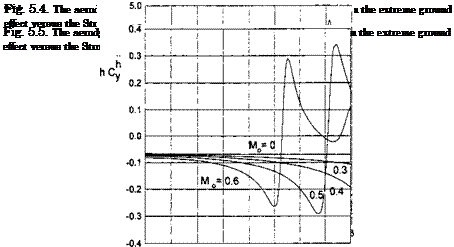 |
Some results for heave derivatives of the lift coefficient, multiplied by the steady state ground clearance, i. e., hCy and hCy are presented in Figs. 5.25.7 versus the Strouhal number and for different Mach numbers for a rectangular wing of aspect ratio A = 1,2,3, oo. The characteristic feature of the curves of (—hCy) as a function of the Strouhal number consists of the oc-
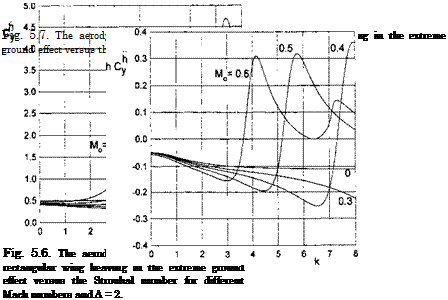 |
A = 2.
currence of pronounced maxima that tend to decrease and shift to smaller Strouhal numbers with increases in the Mach number and the aspect ratio.
The analysis of the curves representing hCy versus the Strouhal number shows that for the range of Strouhal numbers, corresponding to the maxima of (—hCy), points of “loss of vortex damping” appear, i. e., zeros of the
|
Fig. 5.8. The aerodynamic derivative hCy of a rectangular wing heaving in extreme ground effect versus the Strouhal number for different Mach numbers and Л = 3. |
|
к Fig. 5.9. The aerodynamic derivative hCy of a rectangular wing heaving in the extreme ground effect versus the Strouhal number for different Mach numbers and Л = 3. |
quantity hCy. These features of the unsteady aerodynamics of a wing in an unsteady compressible ground-effect flow can be interpreted as an “acoustic resonance.” The theoretical possibility of the occurrence of acoustic resonance was discussed by Sohngen and Quick [140] in connection with unsteady gas flows through axial compressors and within a more general formulation of flat plate cascade oscillations in compressible flow by Gorelov et al. [141].
The same conclusions were drawn by Efremov and Unov [142], who studied oscillations of a foil in a two-dimensional flow in the presence of the ground. Acoustic resonance may take place when the frequency of oscillations of a wing in a restricted compressible flow3 coincides with some of the fundamental frequencies of oscillations of compressible flow with the same boundaries.











